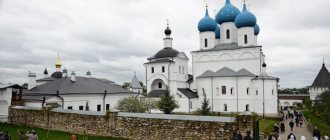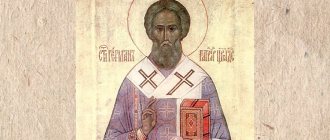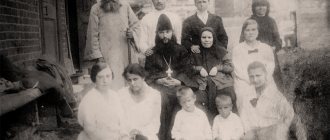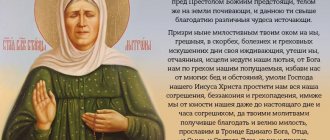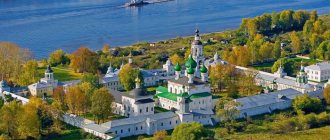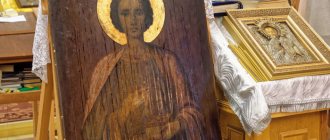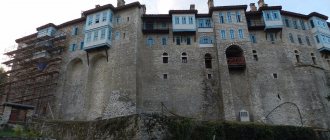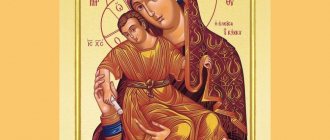People often associate the word “pilgrimage” with a long trip to a holy place, which takes several days and involves modes of transport such as bus or train. However, the pilgrimage can have a slightly different form and be carried out, for example, by metro... And why not? We all know about the wonderful, blessed holy places of our country, such as Diveevo, Optina, Tikhvin, Valaam, but in our capital, golden-domed Moscow, there are also a lot of great shrines, and in order to worship them, you don’t need to go on a long journey at all . So where can you go in Moscow to ask for healing of mental and physical ailments? Let's look at the pilgrimage route by metro to the shrines of the capital.
Pokrovsky Stavropegial Women's Monastery
(metro Taganskaya, metro Marxistskaya, metro Krestyanskaya Zastava, metro Proletarskaya)
The main shrine of the Intercession Monastery is the relics of the Holy Blessed Matrona of Moscow
– many people come to the holy mother every day to ask for help and intercession.
Blessed Matrona of Moscow helps in a variety of needs: in family circumstances, in difficulties with work, in spiritual matters, in the birth of children, and of course, the saint hears requests for healing. There are so many cases of her gracious help that books about the miracles of the holy old woman are now being published. The saint performed miracles during her lifetime, but even after death, many believers receive help and consolation through her prayers. Also in the monastery there is a miraculous icon of the Holy Blessed Matrona of Moscow
, to which there is always a large queue of worshipers.
The monastery also houses the icon of the Mother of God “Seeking the Lost
,” which was painted by order of the holy Matrona herself during her lifetime. At the monastery you can purchase oil and kerchiefs blessed on the relics of the blessed old woman, submit notes and order commemorations, and collect holy water in the chapel. Those who wish to come to venerate Saint Matrona should take into account that usually in the morning there are many pilgrims in the monastery, of which two long lines form: one to the relics of the saint, the other to her miraculous icon (the icon is located on the street). It is better to wear comfortable shoes to make standing in line easier. You can submit notes in the same church where the holy relics of Blessed Matrona rest. The Icon of the Mother of God “Seeking the Lost” is kept in the same church.
Address of the Intercession Monastery
: Moscow, st. Taganskaya 58
The monastery is open every day:
Monday to Saturday from 7:00 to 20:00, Sunday from 6:00 to 20:00
How to get from the metro:
from the Marksistskaya metro station - exit to the street. Taganskaya, then by any transport (bus, trolleybus) to the Bolshaya Andronevskaya stop. From the Krestyanskaya Zastava metro station or Proletarskaya metro station, walk to Abelmanovskaya Zastava Square.
Map of the passage from the metro to the Intercession Convent in Moscow
Schedule of services
Church services in the temple are held daily at 7.30 and 17.00. During the evening service on Monday, an akathist is read to John the Baptist, on Sunday - to St. Nicholas the Wonderworker. Parishioners can bless the water and confess on Sunday morning.
The time of the service on the days of the general church and the patronal holiday (Nativity of John the Baptist - July 7) must be clarified on the website or by calling the information service.
John the Baptist Stauropegial Convent
(m. Kitay-Gorod)
St. John the Baptist Monastery was founded in Moscow back in the 15th century. Its origin is most often associated with the birth of the first Russian Tsar, Ivan the Terrible, who celebrated his namesake on the day of the Beheading of St. John the Baptist. The monastery was often visited and generously given gifts by the first Russian tsars of the Romanov dynasty. In 1918, the monastery was closed, and only in 2002 monastic life in the monastery was resumed.
Saint John the Baptist is a great Prophet and Preacher of repentance, who announced the appearance of the Savior into the world. Its special help and beneficial power in healing head diseases is known. They also pray to the Holy Prophet for the healing of any mental and physical ailments and for the granting of repentance, for a change in way of thinking. Saint John the Baptist helps a person change his life and direct it to Christ.
The most famous shrine of the monastery is the image of the Holy Prophet John the Baptist with a hoop.
This shrine consists of two parts: the icon of St. John the Baptist itself and a metal hoop attached to the icon on a chain and stored in a special casket. During the Soviet years, while the monastery was closed, this ancient monastic shrine was located in the Church of St. Apostles Peter and Paul on the Yauza. On January 19, 2002, the image along with the hoop was returned to the St. John the Baptist Monastery. Now the ancient icon of the Holy Prophet is kept in the monastery cathedral in its historical place, and the revered list with a metal hoop in a casket is in the monastery chapel. Both icons contain particles of the holy relics of the Great Prophet John. The entrance to the chapel is located from the street, in the chapel itself there is an icon of the Mother of God “Seeking the Lost”, an icon of St. Nicholas the Wonderworker and a large monastery shrine - a revered copy of the ancient icon of St. John the Baptist with a particle of relics, a metal hoop is attached to the icon on a chain, which lies in a special casket. On the hoop there is a half-erased but distinguishable inscription: “Holy Great Forerunner and Baptist of the Savior John, pray to God for us.” This hoop has been known since the second half of the 19th century; there is no earlier information about it. It is documented that it was in the chapel, but was attached to another icon - the Beheading of the Holy Prophet. It is not known for certain by whom and for what reason this hoop was made. According to one version, it may be evidence of healing, since it is made to the size of an adult’s head.
In the Orthodox East and in Russia, there is a custom according to which some evidence of a miracle or healing through prayer is attached to miraculous icons: jewelry, jewelry, rosaries, or specially cast images of body parts. Perhaps this hoop was made in the same way as a certificate of healing, but, unfortunately, there is no exact data. Nevertheless, now believers come to the chapel to pray before the revered image of St. John the Baptist and place this ancient hoop on their heads. Believers approach the image of John the Baptist, put a hoop on their head and read a prayer (you can ask it from the attendant behind the candle box), after which they venerate the icon itself. There in the chapel you can purchase and light candles, submit notes, and order a prayer service to the Holy Prophet John the Baptist. There are many known modern healings through prayers in the chapel of St. John the Baptist. Here are a few of them.
In June 2002, a woman contacted the monastery and told the abbess about the miraculous healing of her illness: she had a brain tumor, and she had to undergo surgery to remove it with craniotomy. On the advice of her loved ones, this woman prayed before the icon of St. John the Baptist with a hoop in the monastery chapel. After this, an additional examination was done before the operation - the doctors were amazed and asked the woman what she had done?
In September 2005, another case of miraculous healing was recorded - this time from a thyroid disease. Servant of God N. venerated the icon of St. John the Baptist for the first time and felt a strong burning sensation in the area of the thyroid tumor. The burning did not stop for a long time, and the woman again came to the chapel to venerate the miraculous icon. The next day an examination was carried out, which showed that there was no trace of the tumor.
Another miraculous case of healing in the same 2005 - the servant of God G. had to have surgery on her head. During a fall on the street, the woman hit her head hard, the diagnosis was as follows: a fracture of the frontal bone, a suspended bone fragment, a concussion. This diagnosis was certified in the First City and Fiftieth Clinical Hospitals. The woman was sent for surgery, but she refused hospitalization. Friends advised the servant of God G. to pray to St. John the Baptist. The woman with difficulty reached the monastery chapel to venerate the miraculous icon of the saint with a hoop. Having prayed in front of the image and kissed it and the hoop (she did not know that a hoop could be put on the head), the woman felt a significant improvement. The patient reached home on her own, without outside help. The next day, a CT scan was done, which showed that there was no damage to the skull bones.
These are not all the cases of miraculous healings that occur through the prayers of people in front of the image of the Holy Great Prophet and Baptist John of the Savior with a hoop in the monastery chapel.
Monastery address:
Moscow, Maly Ivanovsky lane. D 2
How to get from the metro:
from the Kitay-gorod metro station - exit the metro to Solyanka street, then walk for 7-10 minutes along Solyansky passage and st. Zabelina.
Map of the passage from the metro to the St. John the Baptist Stauropegial Convent in Moscow
Church of the Holy Equal-to-the-Apostles Prince Vladimir in Starye Sady
(m. Kitay-Gorod)
Directly opposite the St. John the Baptist Monastery, on a hill, there is an amazing white-stone ancient temple, consecrated in honor of the holy Equal-to-the-Apostles Prince Vladimir. This temple is small, but very beautiful. “Old Gardens” is the ancient name of this area, since gardens began to be planted on the southern slope of the hill already in the 14th-15th centuries. The construction of the first church here in honor of St. Vladimir dates back to approximately the time between 1407 and 1417, then most likely it was wooden. In the 16th century, a stone temple was erected instead of a wooden one. During the Soviet years, the Vladimir Church did not escape the fate of many Orthodox shrines: in 1937 they began to dismantle it, but did not finish it. Until the 70s of the 20th century, the temple stood devoid of domes and interior decoration, until its slow restoration began by the 1980 Olympics. Consecration of the Church of St. Equal-to-the-Apostles Prince Vladimir and the first service there took place on May 24, 1991, on the day of remembrance of Saints Equal-to-the-Apostles Cyril and Methodius, teachers of Slovenia.
In this wonderful temple, where prayers have been offered to God for many centuries, there is a miraculous icon of the Mother of God “Healer”.
It is decorated with many jewelry that believers bring as a token of gratitude to the Most Holy Theotokos for Her gracious help and healing.
Church of St. Prince Vladimir in Starye Sadekh before destruction.
The image of the Most Holy Theotokos “Healer” is associated with the healing of one clergyman, Vincent of Bulveninsky. This man had a pious habit, when entering and leaving the church, to kneel before the icon of the Mother of God and briefly pray to Her: “Rejoice, full of grace! The Lord is with you! Blessed is the womb that bore Christ, and the breasts that nourished the Lord God, our Savior!” But one day he became very ill: terrible pain drove him to unconsciousness, and his tongue turned black. Somehow, having come to his senses after another attack of pain, he read his usual prayer to the Most Holy Theotokos and immediately saw an Angel near his head, who was praying with him to the Mother of God, asking him to heal the sick man. After the end of the prayer, the Most Holy Theotokos Herself appeared in extraordinary light and healed Vincent. Feeling completely healthy, he got out of bed and headed to the church, where he stood up to sing in the choir, which brought everyone to great amazement. This miracle was the reason for painting the icon of the Mother of God “Healer”, which has since become the decoration of many hospital chapels and churches.
In the Church of St. Prince Vladimir, prayers are served in front of the miraculous icon of the Most Holy Theotokos “Healer”, notes for which can be submitted on any day.
How to get from the metro:
from the Kitay-Gorod metro station – exit to the street. Solyanka, then along Solyansky Proezd and st. Zabelina.
Temple of the unmercenary saints Cosmas and Damian on Maroseyka
(m. Kitay-Gorod)
Not far from the temple of the Holy Blessed Prince Vladimir in Starye Sadekh there is a temple of the holy unmercenaries Cosmas and Damian, which is on Maroseyka. You can walk from one temple to another in 10-15 minutes. The modern church of Saints Cosmas and Damian was built in 1793, but a church previously stood on this site. It is not known for certain by whom and when it was built. However, there are mentions of it back in the 17th century, from which one can see that the church was stone, one-story and had two altars: the main one - in honor of St. Nicholas the Wonderworker, and the side altar - in honor of Saints Cosmas and Damian. By the end of the 17th century, this church had fallen into disrepair, so in its place in 1793 a new temple was erected, the main altar of which was consecrated in honor of the Savior, who healed the paralytic. The side altar was consecrated in honor of Saints Cosmas and Damian. Based on the main altar, the temple was sometimes called Spassky, although the name “Kosmodamianovsky” was also assigned to the temple.
A parishioner of this temple was the famous Russian poet F.I. Tyutchev, F.M. has been here several times. Dostoevsky.
The temple was closed during Soviet times from 1930. In 1993, it was returned to believers and began to be restored. Now the temple lives a full spiritual life: divine services are held here regularly, there is a Sunday school and a Cultural and Educational Center in the name of St. John Chrysostom.
The main shrines of the temple are the miraculous image of the Savior healing a paralytic
, and
an icon of the unmercenary saints Cosmas and Damian with a particle of their relics.
Also in the temple there is
an image of St. Luke of Crimea with a particle of relics.
On Wednesdays at 5:30 p.m., a prayer service for the sick is served in the church with the reading of an akathist to the holy wonderworkers Kosma and Damian.
The temple is open daily from 8:00 to 19:00, on Sundays until 17:00.
Temple address:
Moscow, st. Maroseyka, 14/2, building 3
Activities of the parish
The tradition of conducting patronage, social and educational activities developed in St. John's parish back in the 18th century. Today it operates a Sunday school for children and adults. Church officials organize regular meetings between young people and interesting people. The parish social service works in the following areas:
- providing assistance to socially vulnerable segments of the population (lonely elderly people, disabled people, homeless people);
- care for orphans, crisis and large families;
- spiritual support for sick people and disabled people;
- working with prisoners.
Divine service in the Church of the Nativity of John the Baptist on Presnya
Church of St. Nicholas in Klenniki
(m. Kitay-Gorod)
On the same street as the Church of Saints Cosmas and Damian, almost a stone's throw from the exit from the Kitay-Gorod metro station, is the ancient Church of St. Nicholas in Klenniki, the main shrine of which is the honest relics of the holy righteous Alexy of Moscow (Mechev).
A church was first erected on this site in the middle of the 15th century, and since then prayers have been offered to the Lord in the temple. It was here that the great holy righteous Alexy Mechev served a century ago. He was born in 1859 and became a wonderful priest, a good shepherd, to whom people flocked for advice, consolation, and spiritual help. He was an elder in the world and accepted everyone who came to him. No one left him unconsoled. He gifted those who came with joy and spiritual joy, and instilled hope in God’s mercy for every person.
Even from childhood, Alexey stood out for his quiet and peaceful character, he avoided quarrels, could console and knew how to amuse and joke - all this came out very piously from him. Those around him called him “blessed Alyoshenka.” Alexey studied at the Zaikonospassky School, then entered the Moscow Theological Seminary. In 1884, he married the daughter of a psalm-reader, Anna Petrovna Molchanova. Their marriage was happy, five children were born in it, but Anna Petrovna suffered from a serious heart disease, and Father Alexei constantly took care of her health. She was his good friend; Father Alexey listened carefully to her comments and considered her his first assistant on the path to Christ. In 1893, Father Alexei was appointed priest of the Church of St. Nicholas in Klenniki, the parish of which was then very small, since large, well-attended churches stood nearby. “For eight years I served the liturgy every day in an empty church,” the holy father later said. Every day in the Church of St. Nicholas in Klenniki, the priest performed services, one could confess and receive communion, while in many other Moscow churches services were held only a few times a week. Grieving people, burdened with sorrows, began to flock to this church to Father Alexei. From them a rumor spread about the good abbot.
But in 1902 Fr. Alexei suffered great grief: his wife, Mother Anna, died of cardiac dropsy. Father Alexey was inconsolable, he said about himself: “The Lord visits our hearts with sorrows in order to reveal to us the hearts of other people. This is how it happened in my life. I had a great grief - I lost my girlfriend’s life after many happy years of life together. The Lord took her and the whole light darkened for me. I locked myself in my room, didn’t want to go out to people, poured out my grief before the Lord.” But the Lord granted Father Alexy a meeting with the great holy righteous John of Kronstadt, who then arrived in Moscow. “Have you come to share my grief with me?” - asked Fr. Alexy, when Fr. entered. John. “I didn’t come to share your grief, but your joy,” answered Fr. John, the Lord is visiting you. Leave your cell and go out to people; only from now on will you begin to live. You complain about your sorrows and think - there is no grief in the world greater than yours, but you be with the people, enter into someone else’s grief, take it upon yourself and then you will see that your misfortune is small, insignificant in comparison with the general grief, and it will become easier for you "
Saint Alexy Mechev accepted these words as new obedience. Father began to receive people in his church, and many people, broken by everyday circumstances, flocked to him, seeking help, advice and consolation. He greeted everyone with heartfelt love, friendliness and compassion. He instilled in people hope for the mercy of God and the possibility of soul renewal. Father Alexy had the gift of clairvoyance, and people who came to him saw that he knew their lives, external events and even thoughts. Saint Alexy became known as a kind father, whom you can turn to in difficult family circumstances. Saint Alexy greatly revered the miraculous “Feodorovskaya” icon of the Mother of God located in the St. Nicholas Church and often served prayer services in front of it.
The holy righteous Alexy Mechevo went to the Lord on June 22, 1923. Now his holy relics rest in the very church where he served, where he received people seeking help and consolation. The vestibule, where his holy relics rest, is open throughout the day. A journal is being kept in which evidence of the help of the holy righteous Alexy Mechev is recorded - more than 300 cases have now been recorded, including healing from the disease of drunkenness, and the giving of children, and relief from very different diseases, and help in everyday needs.
It must be said that the son of St. Alexy Mechev, Sergius, became the rector of the Church of St. Nicholas in Klenniki after the death of his father. He was an outstanding preacher and good shepherd, continuing the work of his father. In 1929, Father Sergius Mechev was arrested, and, like many confessors of the faith of Christ, he spent many years in camps. On January 6, 1942, he was shot in Yaroslavl. Now Saint Sergius Mechev is glorified by the Church as a holy martyr.
Also in the Church of St. Nicholas in Klenniki there is kept the miraculous icon of the Mother of God “Theodorovskaya”
, which was so revered by the holy righteous Alexy Mechev and his son, Hieromartyr Sergius. On Wednesdays, after Vespers, a prayer service is served in front of the miraculous image of the Mother of God with the reading of the canon-paraclesis.
Every day, twice a day, a prayer service is served to the holy righteous Alexy Mechev near the shrine with his relics: in the morning (at 7:45) and in the evening after the end of the evening service.
On Tuesdays (after Vespers) a prayer service is held with an akathist to the holy righteous Alexy Mechev.
Temple address:
Moscow, st. Maroseyka, house 5
Ministry of the rector
Since October 2015, the rector of the Church of the Nativity of John the Baptist on Presnya has been the Archbishop of Vienna and Budapest, Anthony. In the same year he joined the Supreme Church Council of the Russian Orthodox Church. Father Anthony is the head of the Moscow Patriarchate Office for Foreign Institutions. He was appointed administrator of the following foreign dioceses:
- Berlin;
- Italian;
- Vienna-Austrian;
- Budapest-Hungarian.
Anthony received the rank of archbishop in February 2022.
Church of the Life-Giving Trinity on Gryazekh at the Pokrovsky Gate
(metro Kitay-Gorod, metro Chistye Prudy)
From the Church of St. Nicholas in Klenniki to the Church of the Life-Giving Trinity on Gryazekh you can walk along one side of the street without turning anywhere in about 10-15 minutes. The Church of the Life-Giving Trinity on Gryazekh was built in 1861. Previously, there were already temples at this place, which alternately replaced each other. From old photographs you can see how beautiful and majestic this temple was - it was built using Renaissance architectural techniques. However, during Soviet times it was so badly desecrated that now it is not easy to recognize the temple in its appearance. In 1930, the temple was closed and turned into a granary. In the 50s, the temple building was given over to a cultural center: the internal volume of the building was divided by partitions so that there were three floors with many rooms. The vaults of the northern aisle were destroyed and the third floor was built on. At the end of the 70s, a crack appeared on the vault of the temple, which is why they decided to close the cultural center and make major repairs. Only in 1992 the building was returned to believers. The restoration was completed in 2009, but more work remains to be done to restore the bell tower and the central dome.
Particularly revered shrines of the temple are the miraculous icon of the Mother of God “Three Joys”
"and
an icon of the holy Venerable David of Gareji with a particle of his relics.
The icon of the Mother of God “Three Joys” depicts the Mother of God with the Child Christ, the Holy Prophet John the Baptist and the Holy Righteous Joseph the Betrothed. Every Wednesday in the church there is a prayer service with an akathist in front of this icon, which is attended by people from different cities. They usually pray for help for prisoners, for repayment of debts and for family well-being.
The icon of St. David of Gareji with a particle of his relics is especially revered in this temple. It should be noted right away that the icon with a particle of the relics is in the altar and is taken out for veneration during prayer services to the saint. And the rest of the time in the temple on the left side in the icon case there is another icon of the saint, without a particle of relics, with hagiographic marks. In our country, few people know about St. David of Gareji, but in Georgia, where the saint became famous for his exploits, he is revered in much the same way as in our country St. Nicholas the Wonderworker. People turn to him with any requests and in any difficult situations. However, Saint David also has a special grace to help with various women’s ailments and diseases, as well as in healing from infertility and giving children. Georgian women very often resort to this saint for help. Saint David of Gareji is a great Georgian ascetic of the 6th century. He came to Georgia from Syria along with St. John of Zedaznia among his 12 disciples. After 3 years, Saint John sent his disciples to different parts of Georgia, and so on. David and his student settled in the vicinity of Tbilisi. Every Thursday Rev. David descended from the mountain on which he lived to the city to preach the faith of Christ. For this, the local idolatrous priests took up arms against him. They persuaded one seduced girl to blame Saint David for her shame. Residents summoned the saint to trial. The monk approached the girl, touched her womb with his staff and asked: “Am I your father?” A voice came from the womb: “No,” and the true culprit of her sin was named. Then, in front of the astonished people, the maiden gave birth to a stone. And the memory of this wondrous event, through the prayers of the holy Venerable David, was filled with a holy spring on that mountain, the healing properties of which Georgians still resort to for their women’s ailments.
For any female ailments related to childbearing, women ask for the help of St. David, and this help comes. The rector of the Church of the Life-Giving Trinity on Gryazekh, Archpriest John Kaleda, tells many miraculous cases of the help of St. David of Gareji.
Every Monday in the church at 18:00 a water prayer service is served to St. David, and an icon with a particle of his relics is taken out from the altar. There are usually a lot of people present at prayer services, mostly women. You can often see pregnant women in the temple asking the saint for help in bearing and giving birth to children.
On any day in the temple you can purchase water blessed at the prayer service of St. David of Gareji, as well as blessed oil and a small bottle of water from the Georgian spring of St. David. Submit notes for prayer services to St. David and the “Three Joys” Icon of the Mother of God can also be visited on any day.
Temple address:
Moscow, st. Pokrovka 13
How to get from the metro:
1) From Kitay-Gorod metro station, exit to the street. Maroseyka, then walk 10 minutes on the left side of the street (Maroseyka Street turns into Pokrovka Street). 2) From Chistye Prudy metro station (or Turgenevskaya metro station), exit to the Griboyedov monument, then 2 stops on any tram.
